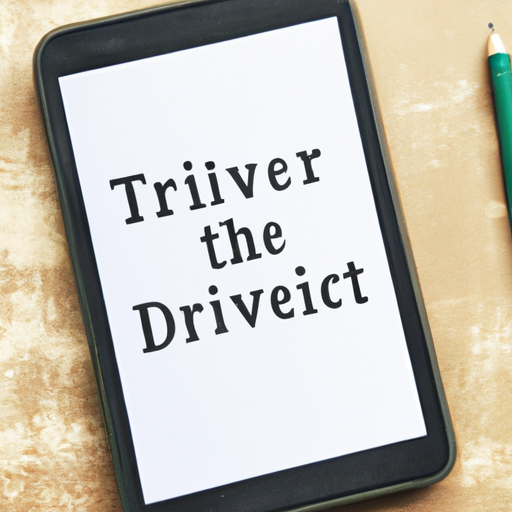Title: Understanding the Role of a Driver: A Comprehensive Guide

1. Responsibilities of a Driver (200 words) A driver's primary responsibility is to transport passengers or goods from one location to another safely and efficiently. Whether it is a taxi driver, truck driver, or chauffeur, their duties extend beyond simply maneuvering a vehicle. They must adhere to traffic laws, maintain the vehicle's condition, and ensure the safety and comfort of their passengers. Additionally, drivers may be responsible for loading and unloading cargo, collecting fares, or providing excellent customer service.
2. Skills Required for Effective Driving (300 words) Driving requires a combination of technical skills, situational awareness, and emotional intelligence. Proficient drivers possess excellent hand-eye coordination, spatial awareness, and the ability to make split-second decisions. They must be skilled in operating various vehicle types, such as cars, trucks, or motorcycles, adapting their driving style accordingly. Moreover, drivers need to be familiar with navigation systems, traffic rules, and road signs to ensure a smooth journey.
Furthermore, drivers must possess strong situational awareness to anticipate potential hazards and react appropriately. This includes being attentive to other drivers, pedestrians, and road conditions. Effective communication skills are also crucial, especially when dealing with passengers or coordinating with other drivers on the road.
3. The Importance of Safe Driving Practices (400 words) Safe driving practices are paramount to prevent accidents, injuries, and fatalities on the road. Drivers must prioritize their own safety, as well as that of their passengers and other road users. This involves obeying speed limits, avoiding distractions (such as mobile phones), and refraining from driving under the influence of alcohol or drugs.
Moreover, defensive driving techniques are essential to anticipate and respond to potential hazards. This includes maintaining a safe following distance, using turn signals appropriately, and being cautious at intersections. Adhering to traffic laws and regulations is not only a legal requirement but also a moral obligation to protect lives and promote a harmonious driving environment.
4. Challenges Faced by Drivers (200 words) Being a driver comes with its fair share of challenges. Traffic congestion, adverse weather conditions, and long working hours can all contribute to stress and fatigue. Additionally, drivers may encounter difficult passengers, encounter road rage incidents, or face the risk of accidents due to the negligence of others. It is crucial for drivers to develop coping mechanisms, practice self-care, and seek support when needed to maintain their mental and physical well-being.
Conclusion (100 words) In conclusion, the role of a driver extends beyond simply operating a vehicle. They bear significant responsibilities, requiring a diverse skill set and a commitment to safe driving practices. By understanding the complexities of this profession, we can foster a culture of respect and appreciation for drivers, ensuring safer roads for everyone. Let us recognize the invaluable contribution of drivers and strive to promote their well-being and professionalism in our society.
Title: Understanding the Role of a Driver: A Comprehensive Guide

1. Responsibilities of a Driver (200 words) A driver's primary responsibility is to transport passengers or goods from one location to another safely and efficiently. Whether it is a taxi driver, truck driver, or chauffeur, their duties extend beyond simply maneuvering a vehicle. They must adhere to traffic laws, maintain the vehicle's condition, and ensure the safety and comfort of their passengers. Additionally, drivers may be responsible for loading and unloading cargo, collecting fares, or providing excellent customer service.
2. Skills Required for Effective Driving (300 words) Driving requires a combination of technical skills, situational awareness, and emotional intelligence. Proficient drivers possess excellent hand-eye coordination, spatial awareness, and the ability to make split-second decisions. They must be skilled in operating various vehicle types, such as cars, trucks, or motorcycles, adapting their driving style accordingly. Moreover, drivers need to be familiar with navigation systems, traffic rules, and road signs to ensure a smooth journey.
Furthermore, drivers must possess strong situational awareness to anticipate potential hazards and react appropriately. This includes being attentive to other drivers, pedestrians, and road conditions. Effective communication skills are also crucial, especially when dealing with passengers or coordinating with other drivers on the road.
3. The Importance of Safe Driving Practices (400 words) Safe driving practices are paramount to prevent accidents, injuries, and fatalities on the road. Drivers must prioritize their own safety, as well as that of their passengers and other road users. This involves obeying speed limits, avoiding distractions (such as mobile phones), and refraining from driving under the influence of alcohol or drugs.
Moreover, defensive driving techniques are essential to anticipate and respond to potential hazards. This includes maintaining a safe following distance, using turn signals appropriately, and being cautious at intersections. Adhering to traffic laws and regulations is not only a legal requirement but also a moral obligation to protect lives and promote a harmonious driving environment.
4. Challenges Faced by Drivers (200 words) Being a driver comes with its fair share of challenges. Traffic congestion, adverse weather conditions, and long working hours can all contribute to stress and fatigue. Additionally, drivers may encounter difficult passengers, encounter road rage incidents, or face the risk of accidents due to the negligence of others. It is crucial for drivers to develop coping mechanisms, practice self-care, and seek support when needed to maintain their mental and physical well-being.
Conclusion (100 words) In conclusion, the role of a driver extends beyond simply operating a vehicle. They bear significant responsibilities, requiring a diverse skill set and a commitment to safe driving practices. By understanding the complexities of this profession, we can foster a culture of respect and appreciation for drivers, ensuring safer roads for everyone. Let us recognize the invaluable contribution of drivers and strive to promote their well-being and professionalism in our society.